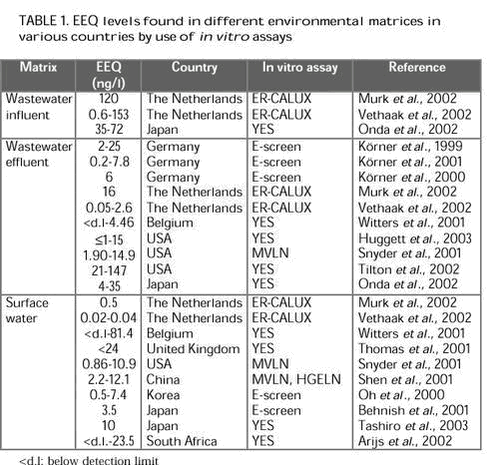Evaluation of in vitro assays for determination of estrogenic activity in the environment4 Estrogenic activity in aquatic environmental samples assessed by in vitro assaysBy utilization of in vitro assays, a variety of substances have been demonstrated to possess estrogenic activity, and many of these have been identified in the environment using chemical analysis. Estrogenic activity in the aquatic environment has primarily been ascribed to the natural steroids, 17 b-estradiol (E2), estrone (E1) and estriol (E3), and the synthetic estrogen, 17a-ethinylestradiol (EE2), used in contraceptives and all being excreted by women and ending up in domestic sewage. To a lesser extent xenoestrogenic chemicals, such as alkylphenols and bisphenol A, may also contribute to the estrogenic activity in the aquatic environment. Environmental water samples thus represent a complex mixture of compounds, including low-potency estrogenic substances (like alkylphenols), which may be present in large quantities, whereas some compounds with very high estrogenic activity (like synthetic or natural estrogens) may be present in trace amounts. The additive behaviour of the estrogenic activity of single substances in a mixture has been demonstrated and this is the basis for quantitatively assessing the total content of estrogenic activity in an environmental sample by use of in vitro assays. The total estrogenicity in the sample is then compared to the magnitude of response elicited by the natural estrogen, E2, and expressed as estradiol equivalents (EEQ). For single compounds, the EEQ value is calculated as the quotient of the EC50 values of E2 and the sample: EEQ = EC50[E2]/EC50[sample]. For extracts of liquid samples, the EC50 is not a concentration but the dilution volume at which 50% of the maximal effect is achieved. The EEQ value is the product of the dilution factor and the EC50 of E2. The EEQ value allows for the quantification of estrogenic activity in the sample without having to know the chemical nature of all estrogenic substances involved. The use of in vitro assays has demonstrated estrogenic activity of wastewater and surface water in numerous countries. In this context, it should be borne in mind that a concentration of 10 ng EEQ/l has been shown to induce intersex (Metcalfe et al., 2001) and a concentration of 5 ng EEQ/l has been shown to induce vitellogenin synthesis in male fish (Thorpe et al., 2001). Körner et al. (1999, 2000, 2001) have used the E-screen assay to assess the estrogenic activity of sewage effluent and sludge from German sewage treatment plants. Analysis of the sewage effluent from five different municipal sewage treatment plants in South Germany showed EEQ values between 2 and 25 ng/l (Körner et al., 1999). In another study EEQ values between 0.2 and 7.8 ng/l were detected (median 1.6 ng/l) in effluents from 16 municipal and two industrial sewage treatment plants in the state of Baden-Wüttemberg, Germany (Körner et al., 2001). Effluent from a modern municipal sewage treatment plant in Germany with a technical standard reported to be very high still contained 6 ng/l EEQ (Körner et al., 2000). Estrogenic potency in wastewater and surface water in the Netherlands was evaluated with three in vitro assays (Murk et al., 2002). The three assays applied were an ER binding assay and two reporter gene assays: YES and ER-CALUX. The EEQ values found in wastewater treatment plants with the ER-CALUX assay were below 120 and 16 ng/l for influent and effluent, respectively. Water extracts from four large rivers all had EEQ levels below 0.5 ng/l. A study of samples from rivers and effluents from municipal wastewater treatment plants in Belgium surprisingly showed the highest estrogenic activity in the surface water compared to the effluent (Witters et al., 2001). 16 water samples were analysed in the YES assay. The estrogenic activity of the water samples ranged from below detection (~2.75 ng EEQ/l) to 81 ng EEQ/l. More than 10 ng EEQ/l were found in 7 of the samples. Thomas et al. (2001) employed the YES assay to assess in vitro estrogenic activity in wastewater and estuarine surface waters in the United Kingdom and found a maximum of 24 ng EEQ/l. Wastewater from four New York and one Texas municipal wastewater facilities was evaluated for estrogenicity using the YES assay (Huggett et al., 2003). Estrogenicity was observed in effluent from two of the New York treatment facilities and from the Texas facility. EEQ values ranged from £1 to 15 ng/l. In Meilang Bay of Taihu Lake (the third largest lake of China) an estrogenic activity of 2.2-12.1 ng EEQ/l has been detected in the MVLN cell assay and the HGELN cell chimeric receptor/reporter gene assay (Shen et al., 2001). In a Korean river the total estrogenic activity was 0.5-7.4 ng EEQ/l as determined by the E-screen (Oh et al., 2000). In a study of estrogenic activity in 25 selected samples from South African inland waters, estrogenic activities as assessed by the YES assay ranged from below detection limit (0.027 ng EEQ/l) to 23.5 ng EEQ/l (Arijs et al., 2002).
|
